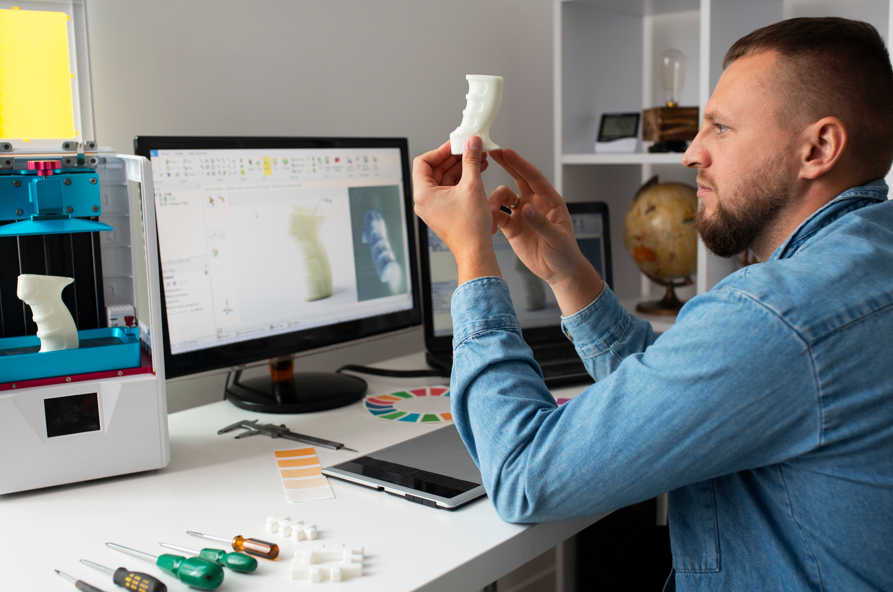With its ground-breaking inventions that are drastically altering medical treatments, 3D printing has revolutionized the healthcare industry in recent years. 3D printing has shown itself to be an incredibly effective tool in addressing difficult medical problems, from making anatomical models to producing customized prosthetics. 3D printing makes it possible to quickly create patient-specific medical solutions, which improves the speed and accuracy of healthcare delivery in contrast to traditional manufacturing methods, which frequently entail labor-intensive processes. This technology has established itself as a key player in contemporary medicine due to its exceptional capacity to create customized, on-demand products.
In the field of prosthetics, the customization that 3D printing offers is especially advantageous. Prosthetic limbs have historically been costly and necessitate numerous fittings and adjustments, which frequently results in major treatment delays. This system has been upended by 3D printing, which makes it possible to produce reasonably priced, custom prosthetics quickly. For example, wait times can be greatly decreased by using 3D-printed prosthetic limbs, which can be made in as little as one day. For young patients who frequently outgrow their prosthetics, this speed is especially helpful because it reduces the need for expensive replacements. Furthermore, patients are now free to select from a range of designs, making the prosthetic procedure more individualized.
| Category | Details |
|---|---|
| Full Name | Michał Wszoła MD, PhD |
| Position | Medical Doctor, PhD in Biomedical Engineering |
| Specialization | Biomedical Engineering, Tissue Engineering, Bioprinting |
| Current Role | Director of Research at a Leading Bioprinting Research Institute |
| Academic Background | MD in Medicine, PhD in Biomedical Engineering |
| Website | www.bioprintingresearch.com |
| Notable Achievements | Pioneering work in the development of 3D-printed organs and tissues |
3D printing also solves comfort and functionality concerns by producing personalized prosthetics that are precisely sized to a patient’s body. In contrast to commercially available options, 3D-printed prosthetics can be made to fit perfectly, reducing discomfort. Better results are also guaranteed by the ability to swiftly modify designs in response to patient input, allowing doctors to fine-tune the fit while the product is being manufactured. In addition to improving many patients’ quality of life, this adaptability has increased prosthetic technology accessibility, providing previously unattainable solutions for some.

Making implants that are unique to each patient is another fascinating use for 3D printing. For instance, 3D printing enables orthopedic surgeons to design unique hip or spinal implants that are precisely tailored to each patient’s unique anatomy. Because traditional implants are frequently standardized, there may be issues and a longer recovery period. But thanks to 3D printing, these implants can be made with extreme precision, greatly lowering the possibility of complications from surgery. Additionally, recovery times are noticeably quicker and the chance of requiring additional corrective surgeries is greatly reduced because the implants are made especially for each patient.
The ability to produce anatomical models for surgical planning and education is among the most remarkable features of 3D printing in the medical field. Before executing complicated procedures on real patients, surgeons can practice and rehearse them using these models, which are created from a patient’s medical imaging data. Medical practitioners can hone their methods, spot possible issues, and eventually enhance patient outcomes by utilizing these realistic models. For complicated or uncommon surgeries where accuracy is essential, this type of pre-operative planning can be extremely helpful.
Bioprinting is arguably the most promising application of 3D printing in healthcare. Researchers are aiming for the lofty objective of printing fully functional organs through the process of bioprinting, which involves printing living cells layer by layer to produce structures that resemble tissue. Even though the technology is still in its early stages, the advancements made so far are extremely encouraging. Indeed, basic tissues like skin and cartilage have already been printed by researchers, and efforts are being made to create more intricate structures like kidneys and livers. Bioprinting has significant ramifications because it may eventually make it possible to create customized organs, which would remove the need for organ donors and shorten the waiting period for life-saving transplants. Additionally, bioprinting could be used to produce tissues for pharmaceutical drug testing, which would eliminate the need for animal testing and guarantee more precise results.
Beyond bioprinting and prosthetics, 3D printing has a wide range of potential uses. Additionally, the technology is being used to create personalized drugs and drug delivery systems. Pharmaceutical companies can create medications in precise dosages that are suited to each patient’s needs by using 3D printing. Treatments that are more effective and have fewer side effects may result from this customization. For instance, the first FDA-approved drug created with 3D printing was the epilepsy medication Spritam. Because of its rapid dissolution due to its 3D-printed design, the medication is more effective for patients who have trouble swallowing pills. This innovation shows how 3D printing can enhance medication delivery and create new opportunities for personalized medicine.
Particularly noteworthy is 3D printing’s potential to lower costs and increase accessibility as it continues to gain traction in the healthcare industry. Large inventories of standard products, which can be expensive and take up valuable space, are no longer necessary for hospitals and clinics thanks to the ability to print custom medical devices on demand. Additionally, 3D printing speeds up the production of medical equipment, allowing patients to receive care more quickly. This quick manufacturing of medical equipment can save lives in emergency situations by giving people instant access to necessary tools.
Notwithstanding the numerous benefits, obstacles still need to be addressed, especially with regard to material constraints and legal requirements. There is still a need for materials that can more closely resemble the characteristics of human tissue, even though the variety of materials appropriate for 3D printing in healthcare is growing. Furthermore, to guarantee their safety and effectiveness, 3D-printed products must pass stringent FDA approval, just like any other medical device. The regulatory framework for 3D-printed goods is still developing since it must take into account the special difficulties presented by this technology, especially in fields like bioprinting and customized medication formulations.
